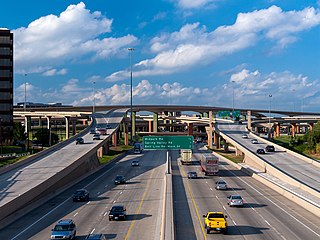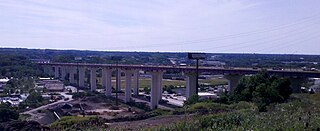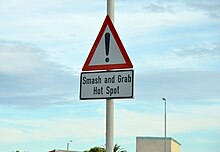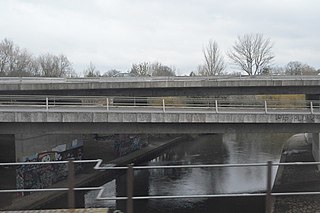
A dual carriageway (BrE) or a divided highway (AmE) is a class of highway with carriageways for traffic travelling in opposite directions separated by a central reservation (BrE) or median (AmE). Roads with two or more carriageways which are designed to higher standards with controlled access are generally classed as motorways, freeways, etc., rather than dual carriageways.

Britannia Bridge is a bridge in Wales that crosses the Menai Strait between the Isle of Anglesey and city of Bangor. It was originally designed and built by the noted railway engineer Robert Stephenson as a tubular bridge of wrought iron rectangular box-section spans for carrying rail traffic. Its importance was to form a critical link of the Chester and Holyhead Railway's route, enabling trains to directly travel between London and the port of Holyhead, thus facilitating a sea link to Dublin, Ireland.

The eastern span replacement of the San Francisco–Oakland Bay Bridge was a construction project to replace a seismically unsound portion of the Bay Bridge with a new self-anchored suspension bridge (SAS) and a pair of viaducts. The bridge is in the U.S. state of California and crosses the San Francisco Bay between Yerba Buena Island and Oakland. The span replacement took place between 2002 and 2013, and is the most expensive public works project in California history, with a final price tag of $6.5 billion, a 2,500% increase from the original estimate of $250 million, which was an initial estimate for a seismic retrofit of the span, not the full span replacement ultimately completed. Originally scheduled to open in 2007, several problems delayed the opening until September 2, 2013. With a width of 258.33 ft (78.74 m), comprising 10 general-purpose lanes, it is the world's widest bridge according to Guinness World Records.

The High Five Interchange is one of the first five-level stack interchanges built in Dallas, Texas. Located at the junction of the Lyndon B. Johnson Freeway and the Central Expressway, it replaces an antiquated combination interchange constructed in the 1960s.

The Narrows Bridge is a freeway and railway crossing of the Swan River in Perth, Western Australia.

The Bandra-Worli Sea Link is a 5.6 km long, 8-lane wide cable-stayed bridge that links Bandra in the Western Suburbs of Mumbai with Worli in South Mumbai. It is the longest sea bridge, as well as the 4th longest bridge in India after Bhupen Hazarika Setu, Dibang River Bridge and Mahatma Gandhi Setu. It contains pre-stressed concrete-steel viaducts on either side. It was planned as a part of the proposed Western Freeway that would link the Western Suburbs to Nariman Point in Mumbai's main business district, but is now planned to become part of the Coastal Road to Kandivali.

Milnerton is a seaside town on Table Bay and is located north of Cape Town in South Africa. It is located 11 kilometres to the north of the city's centre.

A girder bridge is a bridge that uses girders as the means of supporting its deck. The two most common types of modern steel girder bridges are plate and box.

The Medway Viaducts are three bridges or viaducts that cross the River Medway between Cuxton and Borstal in north Kent, England. The two road bridges carry the M2 motorway carriageways. The other viaduct carries the High Speed 1 railway line. All three bridges pass over the Medway Valley Line.

The Mooney Mooney Bridge, officially the Mooney Mooney Creek Bridge, and popularly known as The NSW Big Dipper Bridge, is a twin cantilever bridge that carries the Pacific Motorway (M1) across Mooney Mooney Creek, located near Mooney Mooney in the Brisbane Water National Park on the Central Coast of New South Wales, Australia. The concrete box girder bridge was opened on 14 December 1986 by the Prime Minister of Australia, Bob Hawke, and is owned and maintained by Transport for NSW, an agency of the Government of New South Wales.

The Valley View Bridge is a trio of steel multi-stringer highway girder bridges that carry Interstate 480 over the Cuyahoga River valley in Valley View and Independence, Ohio. They are 215 feet (66 m) high and 4,150 feet (1,260 m) long.

The Schierstein Bridge is 1,282-meter (4,206 ft) long, four-lane highway bridge in Germany. It carries Bundesautobahn 643 over the Rhine River between Mainz-Mombach, Rhineland-Palatinate and Wiesbaden-Schierstein, Hesse. Crossing two arms of the Rhine and the intervening island of Rettbergsaue, the bridge is made of six individual structures, including 100 m (330 ft) from prestressed concrete. It was built between 1959 and 1962.
The Mumbai Trans Harbour Link, also known as the Sewri–Nhava Sheva Trans Harbour Link, (officially Shri Atal Bihari Vajpayee Trans Harbour Link) is an under-construction 21.8 km (13.5 mi) 6-lane access-controlled expressway grade road bridge, which will connect Mumbai with Navi Mumbai, its satellite city. When completed, it would be the longest sea bridge in India. The bridge will begin in Sewri, South Mumbai, will cross Thane Creek north of Elephanta Island, and will terminate at Chirle near Nhava Sheva. The road will be linked to the Mumbai–Pune Expressway in the east and to the under-construction Coastal Road in the west. The 6-lane highway will be 27 meters in width, in addition to two emergency exit lanes, edge strip, and a crash barrier.

The Peats Ferry Bridge is a steel truss bridge that carries the Pacific Highway (B83) across the Hawkesbury River, between Kangaroo Point and Mooney Mooney Point, located 40 kilometres (25 mi) north of Sydney in New South Wales, Australia. The bridge carries the Hornsby to Kariong section of highway, while the adjacent Brooklyn Bridge carries the Pacific Motorway (M1).

Scammonden Bridge, also known locally as the Brown Cow Bridge, spans the Deanhead cutting carrying the B6114 Elland to Buckstones road over the M62 motorway in Kirklees, West Yorkshire, England. The bridge and Scammonden Reservoir to the west are named after Scammonden, the village that was flooded to accommodate the reservoir whose dam carries the motorway. On opening, the bridge was the longest concrete arch bridge in the UK.

The Light Horse Interchange is a motorway interchange located in Eastern Creek, Sydney, Australia at the junction of the M4 and M7 motorways. The interchange is the largest in the southern hemisphere and was opened to traffic in December 2005. The interchange was named in honour of the Australian Light Horse Brigades of World War I, who trained at the Wallgrove Army camp that was located near the site of the interchange prior to deploying overseas.

Auchenshuggle Bridge is a road bridge spanning the River Clyde in Glasgow, Scotland. The Auchenshuggle Bridge is the latest bridge to be built over the Clyde in the Auchenshuggle district of Glasgow, carrying the M74 motorway over the river and onto land which is part of Clydebridge Steelworks in Rutherglen, en route to the M8 junction near the heavily congested Kingston Bridge.

The Hølendalen Bridges are three parallel concrete cantilever bridge which cross Hølendalen in Vestby, Norway. One carries two tracks of the Østfold Line, the other two carry four lanes of European Road E6. The bridges have four spans, the two in center at 128 meters (420 ft) and the two outer at 80 meters (260 ft). The overall lengths are 416 meters (1,365 ft). The bridges are up to 50 meters (160 ft) above the valley and the creek of Såna.

The Obrenovac-Surčin Bridge is the bridge crossing the river Sava in the suburban section of Belgrade, the capital of Serbia. With the partially steel and partially concrete construction today, the building of the bridge began in 1994 when it was conceived as the carrier for the district heating pipeline. The works were halted in 1997 and the project was adapted to include the carriageways. Construction was resumed in 2010 and the bridge was opened on 1 December 2011.






















